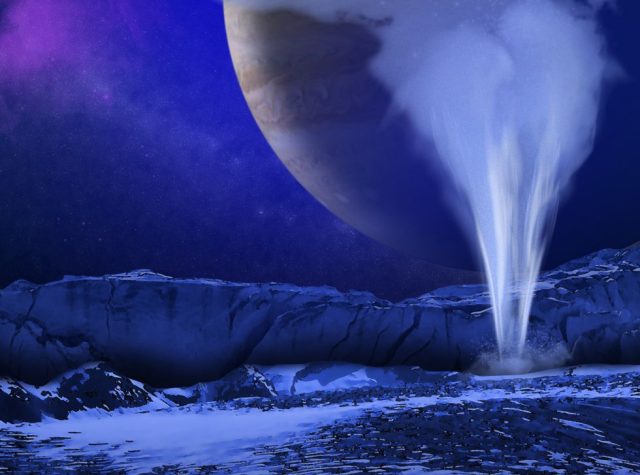
Plumes of water vapor on Europa? A lander could tell us much more.
NASA/ESA/K. Retherford/SWRI
NASA is in various stages of planning two multi-billion dollar missions to Jupiter's intriguing, ice-covered moon of Europa. One, a flyby mission known as the Europa Clipper, will make dozens of passes of the moon down to an altitude of about 25km as it assesses the nature of the ice and the ocean below and looks for clues of habitability. A second even more ambitious mission would seek to actually land on Europa, sample its ice, and look for signs of life.
Both missions, but especially the lander, would be among the most complex, daring, and costly planetary science missions that NASA has attempted. However, both the Clipper and lander are not equally likely to occur. The Clipper is more established. It has been progressing through NASA's multi-tiered review process and has a launch date of 2022. In the president's budget request for fiscal year 2019, it also received $265 million in funding.
The lander mission has always seemed more tenuous, partly because it represents such a breathtaking challenge to land on an icy moon so far away—a nightmare glacier that is irradiated by nearby Jupiter and where the creaky surface rises and falls. In terms of complexity, the Europa Clipper spacecraft has a mass of about 6 tons, and the lander spacecraft will probably end up with a mass of about 16 tons.Worryingly, the lander also received no funding in the fiscal year 2019 budget from the White House. For the time being, it remains reliant on Congress and especially a single representative in the US House of Representatives—Texas Republican John Culberson. In the House budget proposal for 2019, where Culberson sets the topline numbers for NASA as chairman of the authorizing subcommittee, the Clipper mission received $545 million and the lander $195 million. For this reason, the lander mission would benefit from a broader constituency, and that means more buy-in from the US scientific community.
A big step
The lander took a critical step along this path Thursday, when NASA's associate administrator for science, Thomas Zurbuchen, announced the space agency had begun accepting scientific instrument proposals for the robotic lander. "What concept would best help NASA and a potential future robot explore this icy world?" he asked.
The final version of the solicitation, which seeks responses by August 24, highlights the constrained power and data limits of a lander sent all the way to Europa. "The Europa lander mission concept is extremely limited in its ability to accommodate resource growth during mission development, and proposers to this program element must utilize conservative realism when estimating resource needs," the solicitation states.
Among those limitations are: 20-day lifetime on the surface, a total scientific payload mass of just 33kg, an overall energy budget of 1,600 Watt-hours, and a total data volume of 600MB. Along with the scientific instruments being sought, engineers and scientists at NASA's Jet Propulsion Laboratory have already been working for more than a year to develop a specialized cutting saw that can burrow at least 10cm into the ice.Mundane but critical
This solicitation marks a key step forward to making the Europa lander a reality, said the dean of engineering at the University of Colorado-Boulder, Bobby Braun. Historically, as more scientists and engineers become involved in a mission, the more support it gains in the planetary science community. "This mundane federal solicitation may be the start of the most significant planetary science mission to ever be created," said Braun, who has reviewed the Europa mission for NASA and identified ways in which it might control costs.
Originally, the lander mission was estimated to cost about $4 billion, but recent modifications, including the removal of a communications-relay spacecraft in orbit in favor of an upgraded antenna to send data directly back to Earth from the surface of Europa, have reduced those costs significantly.
After studying the mission, Braun said a Europa lander that could find signs of life on another world represents exactly the kind of cutting-edge, daring missions NASA should be pursuing. "For those who like scientifically compelling and technically challenging space science missions, this is a big day," he said. "Selection of a specific scientific instrument is required to further advance the Europa lander design itself. The flight system components and operations concept must be matured around a specific payload—and to date, have been conceptualized assuming a generic payload suite."
Read Again NASA asks for Europa lander science experiments—and that's a big deal : https://ift.tt/2GviilRBagikan Berita Ini














0 Response to "NASA asks for Europa lander science experimentsand that's a big deal"
Post a Comment